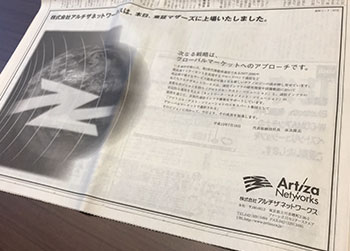

On December 27, 2020, all of us at Artiza Networks celebrate the 30th anniversary since our founding. Beginning as a start-up in 1990 at the dawn of digital communication’s adoption by the general public, Artiza has followed the industry’s journey through the rapid growth of telecommunications, the bursting of the IT bubble, the 2008 financial crisis, and all of its other ups and downs. Having come this far, I am deeply grateful to all of the customers, business partners, shareholders, friends, family, and above all the employees who shared the company’s hardships in difficult times. From the bottom of my heart, thank you.
The year I co-founded Artiza, 1990, was in many ways a seminal year for digital communications. That year, NTT introduced their Integrated Services Digital Network (ISDN), a fully digital public communication network. I was thrilled by the big changes sweeping the telecommunications industry, but at just 30 years old, my excitement was met with equal amounts of anxiety as myself and a few colleagues decided to set out on our own and establish Artiza Networks (formerly known as Able Communications). In a whirlwind of activity, we prepared our plans for the company and at the end of the year, on December 27, 1990, I went to the Tokyo Legal Affairs Bureau in Tachikawa and submitted the company’s papers for incorporation, documents which I had written out entirely by hand.
It was a cold day, and I still remember how the chill intensified my anxiety as I walked back from submitting the papers. We had officially embarked on our journey as a company, but far from being a day of triumph, it was the day our long fight began. There are too many trials and setbacks to recount here, but looking back on those early days, I am proud to say that for 30 years, I never stopped fighting. It seems that such a long time has passed since we started, and yet it feels like yesterday. The company’s journey has been a constant series of changes, and yet nothing really has changed. If I can say the same thing about myself, it seems I have grown, but I’m still the same I was at thirty.

Of all that has happened over the past 30 years, a few events stick out which can rightly be called milestones in the journey to where we are today. The journey through these milestones is now part of the story of our past and the achievements they represent might be easily taken for granted, but at the outset they were enormous, ambitious goals that seemed impossibly far away. We achieved these goals not only through an untiring will to succeed, but also through the triad of "ten, chi, jin," which is a very old concept that translates directly to “Heaven, Earth, and People.” Recently the concept has regained some popularity and in more modern terms it might be called "Fortune, Circumstances, and Employees." It means that our success arose from the opportunities provided by heaven, advantages provided by the terrain or business landscape, and a harmony among our people.

The first such milestone was our initial public offering in 2001. Because the company’s business, which could be considered its responsibility to society, was “to ensure the quality and stability of telecommunications infrastructure,” I was deeply troubled by the ups and downs that the business was going through. To help smooth out the financial peaks and valleys, we decided that Artiza should be managed as a public company, and we made it our goal to get listed on the Tokyo Stock Exchange. From the day we decided to go public until the day of our listing, it was an uphill battle all the way, and there were moments I thought it was impossible. But with the support of the entire company and all of our stakeholders, we made that dream a reality. Today, with over 5,000 shareholders, Artiza Networks is able to maintain its listing on the second section of the Tokyo Stock Exchange.
Artiza crossed another milestone after almost 20 years of being in business when we successfully transitioned into the field of wireless technology. For Artiza, which was founded on the protocols and technology of wired communications, the transition to wireless was truly a leap of faith. We were bewildered by the new technology and its terminology, but eventually the project members persevered through countless cycles of trial and error. Overcoming this hurdle led us to the core of our current business: our always-evolving line of wireless base station testing products. Now, a decade after that sleepless gauntlet of our first wireless project, Artiza has transformed itself from a company working solely on wireline technologies to a leader in the world of wireless technologies. Today, tier-1 base station vendors around the world rely on Artiza’s products to keep their operations running around the clock.

The last milestone in Artiza’s development these past 30 years came when we established new systems for fostering a stronger corporate culture and corporate structure. For a long time, I had contemplated what Artiza needed to become a company that could thrive far beyond my own tenure, and allow young employees to work toward a future where their dreams were realized. In 2009, we adopted “The Artiza Philosophy.” It outlines the company’s vision for what type of conduct will lead our employees to personal and collective success. We produced and distributed booklets, and began reading from them aloud daily at morning meetings and company events. That practice continues even today. Next, in 2014, we transitioned the entire company to a system of “amoeba management,” which aims to foster the management capabilities of as many employees as possible, and put everyone on a path to consistent professional development. We are constantly reviewing and improving this system. The Artiza Philosophy and amoeba management, which define the culture and the structure of the company respectively, have become the two primary engines driving Artiza’s success.

In 2019, just before the company’s 30th Anniversary, I chose to step down as president of Artiza Networks. The company had just released the initial version of our 5G line of products, which had been in development since 2016, and we had cleared a series of important hurdles in sales and marketing for this new generation of products. The role of founders is to create a corporate culture that guides their successors in identifying the right paths from the wrong, and to build a management system that will afford the company sustainable growth. After successfully completing both of these tasks, I was able to pass on command of the company feeling fully satisfied that I had fulfilled my duty as a founder.
The new president has been at the helm since Artiza entered its 30th year, and through his efforts the most recent fiscal year ended with the highest sales in the company’s history. The coming year, too, is progressing smoothly and we are building strong momentum in the 5G era. At the beginning of the current fiscal year we announced our medium-term management goals for the first time since our founding. Under the leadership of our new president, the entire company is united in pursuing these goal. One piece of the medium-term plan is achieving steady improvement in the business’ performance, and to achieve that growth particularly through further expansion of our overseas operations outside Japan. With global adoption of 5G technologies as our tailwind, there’s no limit to how far we can go.
We can all expect great things from the new Artiza Networks.
December 1, 2020
Artiza Networks, Inc.
Chairman & Chief Executive Officer, Co-founder

Takashi Tokonami